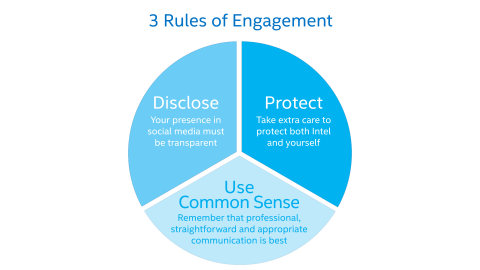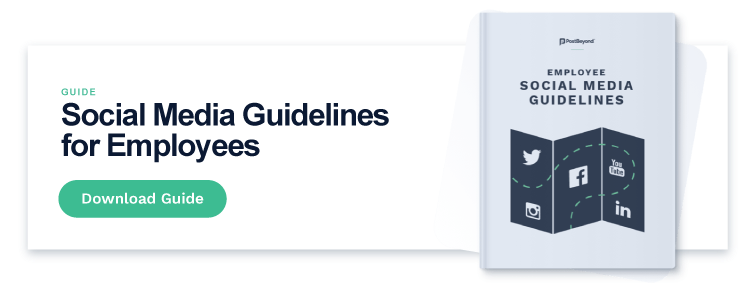So your organization understands the promise of employee advocacy for meeting marketing and sales objectives.
Your next, natural question is: how can you activate and leverage employees and their networks to drive marketing outcomes?
Next up is to launch an employee advocacy program. But this is one big endeavor. If you’re to activate your employees on social media, ensure you have a company-wide social media policy for your employees to follow. Here are some social media policy examples to get you started in the right direction.
What Is a Social Media Policy?
A social media policy is a guidebook or code-of-conduct for employees posting on social media, either as part of their job or in their personal capacity. Because the social media environment is constantly evolving, you’ll need to regularly update your social media policy.
Why Are Social Media Policies Important?
If you’re going to actively manage an employee advocacy program, a social media policy is vital.
Firstly, it removes the worry from sharing anything on social media. One of the biggest reasons for low employee advocacy adoption is rooted in the fear of social media. Employees worry if they say the wrong thing or share the wrong thing, their company or job could be on the line.
Secondly, a social media policy mitigates risk. Organizations worry about PR crises, negative or harmful messaging, or the violation of social media compliance rules. Your social media policy is an effective way of setting rules and boundaries to prevent such problems.
However, a good, up-to-date social media policy does more than mitigate risk. It also sets your employees up for success, giving them guidance on how and where to share posts, etiquette to follow, incentives for sharing in the first place and tips for creating engaging posts.
What to Include in a Company Social Media Policy
It’s important to start with a reminder: your company’s social media policy should empower your employees to engage on social media, not scare them! The main goal is to provide guidelines to make social media use easy and enjoyable.
1. Define Social Media
Start by providing a definition of how your company understands social media. You’ll want to ensure that everyone in your organization is on the same page when it comes to interpreting what social media and social networking mean.
2. Security and Privacy Rules
You’ll want to remind employees of what information is appropriate to share and what they should keep confidential. It would also be a good idea to list specific examples of what your employees can and cannot share.
3. Association Rules
You can guide employees on how to identify themselves as representatives of your company. For example, you can ask them to add certain hashtags to their posts. Otherwise, you’ll want your employees to be as authentic as possible as people trust people more than brands.
4. Copyright and Fair Use
It’s a good idea to offer guidance on crediting the work of others and how to do it. This will help your employees stay within copyright and fair use rules but also encourage them to find useful content from other places.
5. Ethical Standards
You should tie this section of your social media policy to your company’s wider code-of-conduct and ethics policy. You want to ensure your employees understand that their content could easily be saved (e.g., via screenshots). You should also make sure your staff are aware that any false information or messaging used against the company can result in liability.
6. Responsible Engagement
Use this part of your social media policy to emphasize the behaviours your employees can and cannot engage in while on social media. For example, you could tell them to refrain from joining sensitive topics, such as politics or religion, or avoid attacking competing companies.
7. Etiquette
Finally, you can remind your employees to use social media to communicate and connect with others to build relationships and value.
How to Write a Social Media Policy
To get started on writing a social media policy, you can:
1. Get Input From Multiple Departments
Get input and feedback from different departments. You’ll need marketing and legal to sign off, but other groups in the company are stakeholders too. So, talk to public relations, the executive team, HR and others.
2. Make Your Policy Accessible
You should make this document easily findable and accessible to the whole team. A good start would be to append it to your employee handbook and company-wide code-of-conduct.
3. Announce It
Be it a new document or an update/revision, you should make the whole company aware of it. This is a good way to reinvigorate team social media engagement as well as make your newer employees aware of the document.
4. Review It
The social media space is constantly in flux. You’ll come across new platforms and, potentially, move away from others. Not only that, but “content” is also always changing — we couldn’t have imagined TikTok content as a thing ten years ago.
Thus, your social media policy should reflect the environment as it is today. It’s a good idea to set an annual or bi-annual review of the document to ensure it’s up-to-date and relevant.
5. Get a Headstart with Our Social Media Policy Template and Checklist
You’ll get more guidance on how to build a social media policy with our template and checklist.
9 Company Social Media Policy Examples Worth Checking Out
1. Intel details what to do — and what not to do — with social media
Intel’s social media guidelines — made public on the corporate website — make up a crystal clear example of what every social media policy should be. The policy includes words and phrases to avoid, what to do in case of a mistake, key links for employees and more.

The guidelines are explicit without getting into the weeds; they are just as encouraging as they are cautionary. Better yet, the social media guidelines break up the corporate policy into three distinct parts:
1. Disclose your relationship to Intel
The document instructs employees to use the hashtag #IamIntel when posting on social media. According to the guidelines, this “lets people know that you are affiliated with Intel.” But it also goes a long way toward strengthening the Intel brand!
2. Protect Intel
“Protecting Intel is part of your job,” the guidelines state. “Do not post any confidential information on any social platforms. If the information has not been officially released by Intel, don’t discuss it.” Employees are also directed to contact Intel’s social media team when a post is in doubt.
3. Use common sense when posting
Intel doesn’t pull any punches here: “When you are online, you are representing Intel: our people, our values. There is no room for bigotry, prejudice, misogyny, or hatred in our company or on our associated social media feeds.”
2. Best Buy simplifies and philosophizes for its social media policy
The Best Buy social media policy guiding principle is clear: the values and ethics that guide employees in the ‘real’ world are the same as those that guide employees on social media. Even if the document refers to ‘Twittering’ instead of ‘tweeting’, the ideas remain sound.
With its overarching philosophy, Best Buy’s policy is relatively simple, dividing the guidelines into two parts: what employees should do and what employees should never disclose.
Items in the ‘what you should do’ camp include:
- Disclosing your employee affiliation
- Clarifying that statements are your opinion, not representative of Best Buy
- Being careful about the personal information that you share
- Following the retail marketing toolkit when posting offers or promotional content
In contrast, employees are instructed to never disclose operational information and numbers, legal information, customer details and confidential information.
But the policy can be summed up in the three phrases at the top: “Be smart. Be respectful. Be human.”
3. Ford lays out the 11 commandments for social media
Scott Monty was somewhat of a social media pioneer for Ford, back before Facebook hit a billion users and social media became a critical piece of corporate strategy. “Monty has long been a champion of using social media to humanize large organizations by scaling conversations and ultimately building and reinforcing brand trust,” wrote Shel Israel when Monty left Ford.

During the height of his tenure with Ford, Monty shared the essence of the company’s internal social media strategy with Fast Company. The platforms may have shifted, but this is still great stuff:
- Be honest about who you are
- Make it clear that the views expressed are yours
- You speak for yourself, but your actions represent those of Ford Motor Company
- Use your common sense
- Play nice
- The Internet is a public space
- The Internet remembers (i.e., “Whatever happens in Vegas…stays on Google.”)
- An official response may be needed
- Respect the privacy of offline conversations
- Same rules and laws apply: new medium, no surprise
- When in doubt, ask
4. ACFE provides a workable social media policy template
If you’re looking for a full social media policy template, the Association of Certified Fraud Examiners — the world’s largest anti-fraud organization — published a full PDF. The document is ready to be adapted for your own company use.
The template could be particularly helpful because it is highly situational. Each bullet point is specific but also points employees to other resources that can guide social media actions. These include the Code of Conduct, employee handbook, HR department, spokespeople and more.
5. Dell boils it all down to a handful of critical pointers
Dell’s social media policy is broken down into six distinct elements, ranging from the more specific Code of Conduct to more general directives like “Be responsible.” Arguably the most important element in the policy is also the first: “Be nice, have fun and connect.”
In this section, Dell is clear in its intention with employee social media use: “The connections you’ll make on social media will be much more rewarding if you remember to have conversations rather than push agendas. Dell has always been a leader in using technology to directly connect with our customers. Social media is another platform you can use to build our brand, just be sure you do it the right way.
This straightforward document stands in stark contrast to something like the social media policy from the US Office of Personnel Management, complete with appendices, required disclaimers, direct message guidelines and more.
You definitely want to be clear about your social media policy. But sometimes less is more, and simple is best.
6. Adobe sets boundaries from the start
Adobe references its social media guidelines in its main employee code of conduct document. This section is short, so there is likely a dedicated internal document.
However, the neat thing about Adobe’s approach is that it signifies that its social media is a key part of its main code-of-conduct policies. It also sets clear boundaries of how employees can or cannot conduct themselves. For example, Adobe states that employees do not represent the company or speak for it unless they are authorized to do so by Adobe Public Relations.
7. Edmunds guides you visually
Edmunds offers an effective way of presenting your social media policy. You can take a visual approach that clearly segments each part of the policy (such as confidentiality and discretion).
Overall, Edmunds also opted to keep a relatively succinct document (it’s only one page).
8. ESPN
The interesting thing about ESPN is that its public-facing employees (e.g. journalists, reporters and talking heads) represent the company. So, it follows that ESPN’s social media policy is a bit more cautious in its rules than some of our other examples.
If you’re a news publisher or media company, you may need a more granular set of rules so as to maintain the best interests of both your brand and employees. ESPN offers a good example of how to write those guidelines in response to many different contexts, such as politics and/or social issues, among others.
9. Pfizer
Pfizer operates in waters heavy with regulatory oversight, so it (like ESPN) maintains a more cautious and granular social media policy. Like Adobe, Pfizer summarizes the main points of its social media guideline in its main code of conduct document so that every employee is aware.
This summary establishes clear rules about how an employee can represent themselves and when to disclose their affiliation with Pfizer.
Align marketing and compliance teams
How can your employees use social media while complying with the rules and regulations that govern our organization?
Collaborate closely with your compliance team to understand the latest regulatory compliance policies and stay in the loop for any ongoing changes. In return, you can also share details on the latest changes across social media marketing and your corporate social media strategy so they can identify any potential risks.
Use these 5 social media policy examples for inspiration to help you craft your company’s version. By aligning both departments, you can align on a crystal clear social media policy that fosters the right behaviors for employee advocacy.






